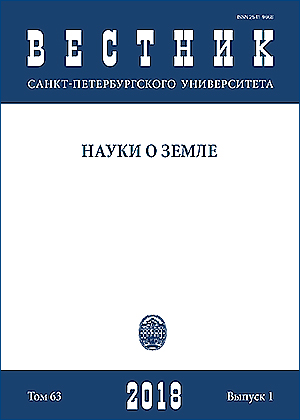Synrift deposits of the lower part of the Riphean stratotype, Southern Urals (a short lithochemical characterization)
DOI:
https://doi.org/10.21638/11701/spbu07.2018.103Abstract
The study of the bulk chemical composition of the sandstones of the Ai Formation of the Burzyan Group of the Southern Urals (the stratotype of the Lower Riphean of Northern Eurasia) led to the conclusion that they contain products of destruction of both the crystalline basement rocks of the East European Platform and the sedimentary/metasedimentary rocks of its platform protocover. In the composition of sandstones and associated clay rocks, there appears to be a noticeable portion of lithogenous (repeatedly redeposited) material. Clay rocks of the Ai Formation do not contain the so-called “camouflaged pyroclastics”, and, consequently, the processes of their accumulation were not accompanied by erosion of volcanic rock or synchronous explosive activity. As a whole, low values of the chemical index of alteration (CIA) are inherent for fine-grained terrigenous formations. This makes it possible to assume their formation under conditions of relatively pronounced tectonic activity in catchment areas, possibly minimized by the effects of chemical weathering processes. A comparison of the bulk chemical compositions of the terrigenous rocks of the Ai Formation with the composition of the average Proterozoic craton sandstone, PAAS and a number of other reference geological objects has shown that they are characterized by fairly wide variations in the content of the main rock-forming oxides (significant chemical immaturity of the composition), which can also be regarded as a reflection of their accumulation in sufficiently active tectonic environments. Analysis of the bulk chemical composition of sandstones and clay rocks of the Ai Formation suggests that the sources of the clastic material were as acid magmatic rocks as sedimentary and/or metasedimentary rocks with an increased amount of quartz; this is consistent with the results of previous mineralogical-petrographic studies. The position of the individual data points of sandstones and clay rocks of the Ai Formation on the DF1–DF2 diagram (Verma and Armstrong-Altrin, 2013) does not allow us to draw a definite conclusion about their paleogeodynamic nature, since one part of the points is located in the field that is characteristic for sedimentary rocks of riftogenic environments, and the other lies in the field typical for collision environments. More specifically, in favor of the riftogenic/synrift nature of the terrigenous rocks of the Ai Formation, the distribution of the data points of their average compositions on the DF1—DF2 diagram is evidence.
Keywords:
Southern Urals, Lower Riphean, Ai Formation, sandstones, clay rocks, lithochemistry
Downloads
References
References
Nauka, Moscow. (In Russian)
Downloads
Published
How to Cite
Issue
Section
License
Articles of "Vestnik of Saint Petersburg University. Earth Sciences" are open access distributed under the terms of the License Agreement with Saint Petersburg State University, which permits to the authors unrestricted distribution and self-archiving free of charge.






